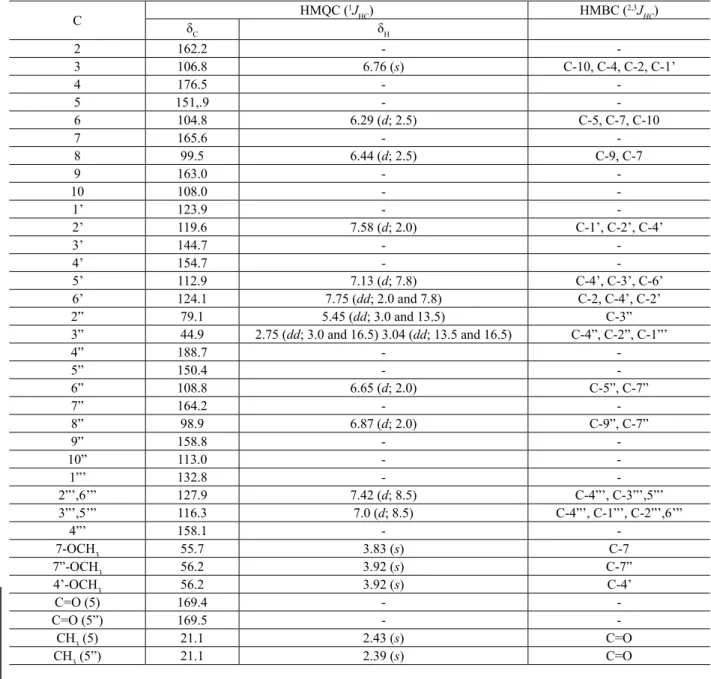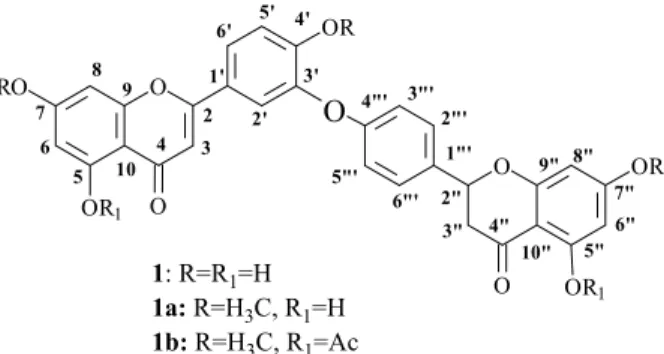33 Revista Brasileira de Farmacognosia
Brazilian Journal of Pharmacognosy 19(1A): 33-35, Jan./Mar. 2009
* E-mail: mgeraldo@ufrrj.br, Tel./Fax +55-21-2682-2807 ISSN 0102-695X
Received 17 July 2008; Accepted 9 December 2008
Artigo
A new derivative of dihydroochnalavone isolated from
Luxemburgia
species
(Ochnaceae) and the complete
1H and
13C NMR chemical
shifts assignments
Mario G. de Carvalho*, Virginia C. Silva, José G. da Rocha Jr
Departamento de Química, Instituto de Ciências Exatas, Universidade Federal Rural do Rio de Janeiro, BR 465 KM 07, 23890-000, Seropédica-R.J, Brasil
RESUMO: “Um novo derivado da dihidroochnalavona isolada de Luxemburgia species (Ochnaceae) e o completo assinalamento dos dados de RMN de 1H e 13C”. O bilavonóide
2”,3”-diidroochnalavona, isolada de espécies de Luxemburgia (Ochanaceae), foi tratada com diazometano e forneceu o éter trimetílico que, em seguida, foi tratado com anidrido acético/piridina obtendo-se um novo derivado, 5-acetil-7,4’-dimetil-lavona-(3’→O -4’”)-5”-acetil-7”-metil-lavanona. Fez-se o completo assinalamento dos dados de RMN 1H e 13C através da análise dos
espectros uni- e bidimensionais do derivado.
Unitermos: Ochnaceae, Luxemburgia, bilavona, trimetil-diacetil-diidroochnalavona.
ABSTRACT: The bilavonoid 2”,3”-dihydroochnalavone, isolated from the Luxemburgia species (Ochanaceae), was treated with diazomethane to obtain the trimethyl-ether that was treated with pyridine/acetic anhydride to yield a new derivative, 5-acetil-7,4’-dimethyl-lavone-(3’→O -4’”)-5”-acetil-7”-methyl-lavanone. The complete 1H and 13C NMR data assignments of the new derivative
were made by the one- and two-dimensional spectral analysis.
Keywords: Ochnaceae, Luxemburgia, bilavone, trimethyl-diacetyl-dihydroochnalavone.
INTRODUCTION
The antitumor and cytotoxic activities of
bilavonoids isolated from Luxemburgia species
have been evaluated. Two natural bilavonoids 2”,3”-dihydroochnalavone and luxenchalcone was
cytotoxic to murine Ehrlich carcinoma and human cells lines. The acetyl and the methyl derivatives were not cytotoxic to the analyzed tumour cells lines (Daniel et al.,
2007; Oliveira et al., 2005). Species of Ochna, Ouratea
and Luxemburgia (Ochnaceae) are great source of these
natural bilavonoids (Likhitwitayawuid et al., 2001; Carvalho et al., 2002, 2004; Carbonezi et al., 2007).
Besides the structural determination, we have analyzed
the spectral data of the natural bilavonoids and their
new derivatives (Carvalho et al., 2006a,b; Carvalho et al., 2003, Carvalho and Daniel, 2005). In this paper we describe the preparation and the complete proton and carbon-13 NMR assignments of a new derivative of
2”,3”-dihydroochnalavone.
MATERIAL AND METHODS
General procedures
Melting points are uncorrected. Fourier transform
NMR spectra were recorded on a Varian INOVA-500 model spectrometer operating at 500 MHz for 1H and 125 MHz for 13C. The NOE-difference experiment was recorded on a Bruker AC200 spectrometer operating at 200 MHz for 1H. Samples were analyzed in 5 mm tubes, using CDCl3 as solvent containing tetramethylsilane as
internal standard. The natural bilavone (1) was isolated from the leaves of Luxemburgia nobilis and from L. octandra as described in the literature (Carvalho et al.,
2002; Carvalho et al., 2004).
Preparation of 5,5”-diacetyl- 7,4’,7”-trimethyl-2”,3”-dihydroochnalavone (1b)
The new derivative 1b was prepared by treating
a methanol solution of the natural bilavone 1 (50.0 mg) with ethereal diazomethane solution prepared as the procedure described by Carvalho et al (2006b). After evaporation of the solvents, the residue was dissolved
in acetone and puriied by CC on silica gel. The fraction
Rev. Bras. Farmacogn. Braz J. Pharmacogn. 19(1A): Jan./Mar. 2009
34 34
Mario G. de Carvalho, Virginia C. Silva, José G. da Rocha Jr
RESULTS AND DISCUSSION
The number of methoxyl groups detected by 1H and 13C NMR spectra of the derivative 1a let us to
conirm the dimmers structure. If it was a mixture of monomers (lavone and lavanone) this product would have ive methoxyl groups. The analysis of 13C NMR (BBD and DEPT) spectra of compound 1b led us to identify twelve sp2 CH including two signals at δ
CH 127.9 and 116.3, each representing two carbon atoms; signals of sp3 carbons at δ
CH 79.1 and δCH2 44.9 besides methoxyl and methyl groups; fourteen quaternary sp2 carbons (4xC
and 10xC-O) and four carbonyl groups at δC 188.7, 176.5,
169.5 and 169.4 were identiied. In the 1H NMR spectrum
were identiied ten protons of aromatic ring including
two sets of meta-coupled doublets (1Hx1H-TOCSY) at δ H
6.29 and 6.44 (J = 2.5 Hz) and at δH 6.65 and 6.87 (J
= 2.0 Hz) which belong to the 6, 8, 6” and 8” protons
of two lavonoid moieties (Table 1). The paramagnetic
larger shift of the protons H-8/H-8” in comparison with H-6/6”, reveals that, when the acetyl group is sterically hindered, the effect in para is more pronounced than in ortho effect in consequence of the shielding effect of the carbonyl group, the widespread statement when it is attributed major ortho effect of acetyl (Carvalho &
Braz-Filho, 1993). The presence of a singlet at δH 6.76 (H-3)
and the double doublets at δH 5.45 (J1 = 13.5 and J2 =
3.0 Hz; H-2”), 3.04 (J1 = 16.5 and J2 = 13.5 Hz; H-3”ax)
and at δH 2.75 (J1 = 16.5 and J2 = 3.0 Hz; H-3”eq) were
similar to those of 1 and 1a. The chemical shifts of ring B
proton in the lavone moiety was identiied by the signals at δH 7.13 (d, J = 8.7 Hz, H-5’), 7.58 (d, J = 2.0 Hz, H-2’)
and 7.75 (dd, J1 = 7.8 and J2 = 2,0 Hz, H-6’) Table 1.
The AA’BB’ system was presented by two doublets (J=
Table 1.1H (500 MHz) and 13C (125 MHz) NMR spectral data of 1b.
C HMQC (
1J
HC) HMBC (
2,3J HC)
δC δH
2 162.2 -
-3 106.8 6.76 (s) C-10, C-4, C-2, C-1’
4 176.5 -
-5 151,.9 -
-6 104.8 6.29 (d; 2.5) C-5, C-7, C-10
7 165.6 -
-8 99.5 6.44 (d; 2.5) C-9, C-7
9 163.0 -
-10 108.0 -
-1’ 123.9 -
-2’ 119.6 7.58 (d; 2.0) C-1’, C-2’, C-4’
3’ 144.7 -
-4’ 154.7 -
-5’ 112.9 7.13 (d; 7.8) C-4’, C-3’, C-6’
6’ 124.1 7.75 (dd; 2.0 and 7.8) C-2, C-4’, C-2’
2” 79.1 5.45 (dd; 3.0 and 13.5) C-3” 3” 44.9 2.75 (dd; 3.0 and 16.5) 3.04 (dd; 13.5 and 16.5) C-4”, C-2”, C-1”’
4” 188.7 -
-5” 150.4 -
-6” 108.8 6.65 (d; 2.0) C-5”, C-7”
7” 164.2 -
-8” 98.9 6.87 (d; 2.0) C-9”, C-7”
9” 158.8 -
-10” 113.0 -
-1”’ 132.8 -
-2”’,6’” 127.9 7.42 (d; 8.5) C-4”’, C-3”’,5”’ 3”’,5’” 116.3 7.0 (d; 8.5) C-4”’, C-1”’, C-2”’,6’”
4”’ 158.1 -
-7-OCH3 55.7 3.83 (s) C-7
7”-OCH3 56.2 3.92 (s) C-7”
4’-OCH3 56.2 3.92 (s) C-4’
C=O (5) 169.4 -
-C=O (5”) 169.5 -
-CH3 (5) 21.1 2.43 (s) C=O
Rev. Bras. Farmacogn. Braz J. Pharmacogn. 19(1A): Jan./Mar. 2009
35 35
A new derivative of dihydroochnalavone isolated from Luxemburgia species(Ochnaceae) and the complete 1H and 13C NMR
8.5 Hz, 2H each) at δ 7.42 and 7.0 which were assigned to H-2”’,6”’ and H-3”’,5”’ of the lavanone moiety,
respectively. The cross peaks of heteronuclear long-range couplings observed in the 13Cx1H-COSY-nJ
CH (n = 2 and 3, HMBC) spectra of 1b were used to identify the chemical shift of quaternary carbons (Table 1). The
signals of H-3 with C-10, C-4, C-2, C-1’; of H-6 with C-5, C-7 and C-10 besides signals of H-8 with C-7, C-9 and C-10 conirmed the chemical shifts of quaternary carbons of ring A of the lavone moiety (Table 1). The
spectra obtained from NOEDIFF-NMR experiments of 1b showed NOE signals at δ 7.13 (d, H-5’), 6.29 (d, H-6),
6.44 (d, H-8), 6.65 (d, 2.0 Hz, H-6”) and 6.87 (d, H-8”) with irradiation at the methoxy groups; additional NOE
signals at δ at 3.04 3a), 2.75 3b) and at 7.42 (H-2”’,6”’) with irradiation in thefrequency of H-2” (δH 5.45)
conirmed the AA’BB’ system located in the lavanone moiety. These observations conirmed the C-3’→O-C-4’” connection between the lavone and lavanone moieties.
The comparison of the 13C NMR spectral data with those of 1 (Carvalho et al., 2002), along with the analysis of the 13Cx1H-COSY, nJ
CH (n = 1, HMQC, n = 2 and 3, HMBC),
allowed to deine the structure and make the complete
proton and carbon-13 NMR chemical shift assignments
of the new bilavonoid derivative 5,5”-diacetyl-(3’-O-4”’)-7,4’,7”-trimethyl dihydroochnalavone (1b, Table 1).
ACKNOwLEDGEMENTS
The authors are grateful to CNPq, FAPERJ
and CAPES for a research fellowship and for inancial
supports and to Instituto de Química/UNESP/Araraquara for the 500 MHz NMR spectra.
REFERENCES
Carbonezi CA, Hamerski L, Gunatilaka AAL, Cavalheiro A, Castro-Gamboa I, Silva DHS, Furlan M, Young MCM, Lopes MN, Bolzani VS 2007. Bioactive lavone dimers from Ouratea multilora (Ochnaceae).
Rev Bras Farmacogn 17: 319-324.
Carvalho MG, Braz-Filho R 1993. Novas técnicas de RMN e os deslocamentos químicos dos átomos de 1H e 13C da
isolavana duartina. Quim Nova16: 89-94.
Carvalho MG, Oliveira MCC, Silva CJ, Werle AA 2002. New bilavonoid and other constituents isolated from
Luxemburgia nobilis. J Braz Chem Soc 13: 119-123. Carvalho MG, Alves CCF, Santos VMR, Schripsema J 2003. O
completo assinalamento de RMN 1H e 13C de novos
derivados da luxenchalcona isolada de Luxemburgia
octandra. Rev Univ Rural, Ser Ci Exatas e da Terra
22: 89-95.
Carvalho MG, Alves CCF, Silva KGS, Werle AA, Eberlin MN 2004. Luxenchalcone, a new bichalcone and other constituents from Luxemburgia octandra. J Braz
Chem Soc 15: 146-149.
Carvalho MG, Daniel JFS 2005. 1H and 13C-NMR assignments
of two new derivatives from lanaralavone, a 4’-O-8” bilavone dimer from Ouratea hexasperma
(Ochnaceae) Ann Magn Reson4: 29-34.
Carvalho MG, Gomes MSR, Pereira AHF, Daniel JFS, Schripsema J 2006a. Carbon-13 and proton NMR assignments of a new agathislavone derivative. Magn Reson Chem44: 35-37.
Carvalho MG, Jr JGR, Cavatti LC, Suzart LR, Cornelius MRF, Silva VC, Cardozo MAR. 2006b. Determinação estrutural de lavonóides com análise de espectros de RMN de 1H 1D e reação com diazometano. Rev Univ
Rural, Ser Ci Exatas e da Terra25: 1/2, 46-60. Daniel JFS, Alves CCF, Grivicich I, Rocha AB, Carvalho MG
2007. Antitumor activity of lavonoids from Ouratea
and Luxemburgia on human cancer cell lines. Indian J
Pharmacol39: 184-186.
Likhitwitayawuid K, Rungserichai R, Ruangrungsi NR, Phadungcharoen T 2001. Flavonoids from Ochna
integerrima. Phytochemistry56: 353-357.
Oliveira MCC, Carvalho MG, Grynberg NF, Brioso PST 2005. Bilavonoid from Luxemburgia nobilis as inhibitor of topoisomerases. Planta Med71: 563-566.
1: R=R1=H
1a: R=H3C, R1=H
1b: R=H3C, R1=Ac 2
3 4
5 6 7
8 9
10 1'
2' 3' 4' 5' 6'
2"
3" 4" 5"
6" 7" 8" 9"
10" 1"' 2"' 3"' 4"'
5"' 6"'
O
O
OR
OR1 O
O RO
OR1 O
OR
Figure 1. Structures of 2”,3”-dihydro-ochnalavone and its

